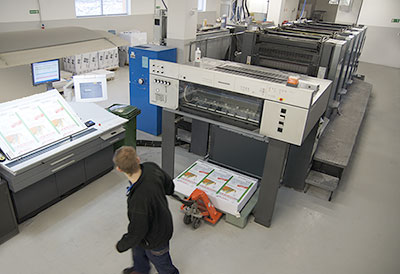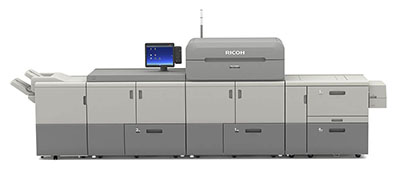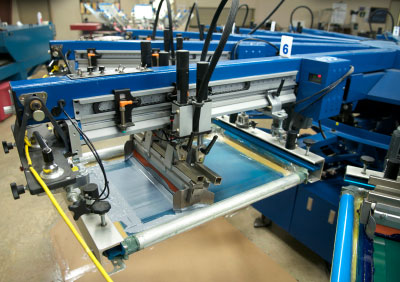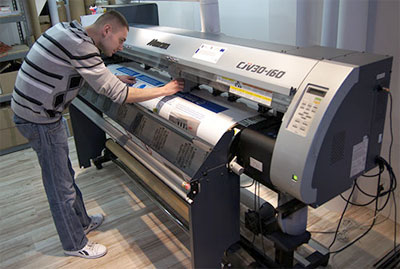



Printing Technologies
Laser Digital Printing Technology
Laser digital printing is one of the most advanced technologies in the printing industry, especially popular in production digital printing. Based on electrophotography, this process combines advanced laser technology with precision and speed, making it an ideal solution for low-volume but also medium-volume print runs.
Features:
- Moderate resistance to UV radiation and high abrasion resistance, making this technology suitable for both indoor and outdoor use.
- Print resolution comparable to offset printing.
- High depth and uniformity of solid colors (large areas of full ink coverage, e.g., an entirely black page).
- Good uniformity of solid surfaces printed from a halftone (halftones).
- Good quality of long tonal transitions, e.g., from black to white.
- This technology only uses the CMYK color palette - full color, allowing for high-quality photo and graphic printing.
- Low coverage capability excludes printing on most clear and colored films.
- More about laser digital printing
Advantages of Digital Technology:
-
Flexibility and Personalization: Laser printing enables variable data printing (VDP), which is key for personalizing materials such as personalized brochures, letters, or promotional materials.
-
High Quality: This technology guarantees high print quality, with clear texts and detailed graphics, important for both marketing materials and company documentation.
-
Short Turnaround Time: Digital printing eliminates the need for plate and form preparation, reducing preparation time and enabling on-demand printing.
-
Cost-Effective for Short Runs: Due to the absence of form preparation costs, laser digital printing is more cost-effective for short runs compared to traditional offset printing methods.
-
Ecology: Laser digital printing generates less waste compared to traditional methods and allows for accurate material quantity prediction, reducing overproduction.
- Large Format: This technology allows printing up to B0 format.
Disadvantages of Digital Technology:
- Lack of availability of other color palettes than CMYK,
- Low coverage capability excludes printing on clear substrates,
- Relatively expensive for large volumes.
- Limited format to 700x330 mm or 700x500 mm.
Applications:
Laser digital printing is widely used in the production of advertising materials such as leaflets, brochures, posters, and in office printing, labels, books on demand, and many others. Its versatility makes it preferred by companies needing high-quality prints in a short time.
In summary, production laser digital printing is an advanced technology that combines precision, quality, and flexibility, being both an economical and environmentally friendly alternative to traditional printing methods.
Offset Printing Technology
Offset printing is one of the most popular and widely used technologies in the printing industry, mainly used for producing high-quality printed materials in large quantities. This process is characterized by high precision, efficiency, and the ability to print on various substrates. Here is a detailed description of offset printing technology:
Features:
- Low abrasion and UV resistance - not recommended for outdoor use or only for short-term applications.
- The highest resolution available in printing technologies, averaging 2400 - 3000 DPI, allows printing photographic quality photos and graphics.
- High depth and uniformity of solid colors (large areas of full ink coverage, e.g., an entirely black page).
- Good uniformity of solid surfaces printed from a halftone (halftones).
- Excellent quality of tonal transitions, e.g., from black to white.
- Diversity of available color palettes, including CMYK - full color and Pantone (printing with pre-mixed colors like white, gold, silver, etc., and others unavailable in CMYK).
- Low coverage capability excludes printing on clear films as well as dark backgrounds.
Inks and Substrates
Offset printing uses special printing inks, which can be oil-based or water-based. These inks are carefully selected to ensure proper adhesion to the printing form and substrate and image durability. Offset allows printing on various types of paper as well as other substrates, such as cardboard, foils, or fabrics.
Advantages of Offset Printing
- High Quality: Offset allows for very precise details and a rich color palette.
- Cost-Effective for Large Volumes: Unit costs decrease as the volume increases, making offset ideal for mass production.
- Substrate Flexibility: Ability to print on various materials.
- Repeatability: Every print is identical, which is crucial for producing materials like books, catalogs, or magazines.
Disadvantages of Offset Printing
- High Plate Preparation Cost: The process of preparing the printing form and machine is expensive and time-consuming, making this technology not cost-effective for small volumes.
- Not Cost-Effective for Small Runs: Offset is economical mainly for large runs.
Applications of Offset Printing
Offset printing is widely used in the production of books, magazines, catalogs, posters, leaflets, packaging, and many other materials that require high print quality and are produced in large quantities.
Summary
Offset printing is a technology that, despite the development of digital printing methods, remains indispensable in many applications, especially where quality and production economy for large volumes matter. Thanks to its flexibility and the ability to print on various substrates, offset finds wide application in different fields of printing.
Large Format Digital Printing
Large format printing technology is a key element in the printing industry, especially in fields such as outdoor advertising, exhibition displays, interior decoration, or the creation of promotional materials. It is a process that enables printing on large formats, far exceeding standard sheet sizes, such as A3 or A2.
Features:
- High UV resistance and moderate abrasion resistance make this technology suitable for both indoor and outdoor use, in the form of vehicle stickers, store window graphics, etc.
- Estimated durability provided by ink manufacturers is 2-3 years. With the application of laminate or protective varnish, durability can be higher.
- This technology uses the CMYK color palette - full color, allowing high-quality photo and graphic printing.
- Low coverage capability excludes printing most colors on clear as well as colored films.
- More about solvent printing
Types of Large Format Printing Technology
-
Inkjet Printing:
- Piezoelectric and Thermal Technology: In piezoelectric technology, ink is ejected from the printer nozzles under pressure generated by piezoelectric elements. In thermal, the ink is heated, causing its expulsion. Inkjet printers are very versatile and can print on various materials such as paper, foil, canvas, vinyl, and even fabrics.
- Applications: Ideal for creating banners, posters, billboards, exhibition materials, wall graphics, and many other products requiring high-quality images on large formats.
-
Solvent and Eco-Solvent Printing:
- Solvent Technology: This technology uses solvents that dissolve the ink pigments, allowing printing on difficult substrates such as vinyl, foil, or other plastics. Solvent is very durable, weather-resistant, making it ideal for outdoor applications.
- Eco-Solvent Technology: It is a more environmentally friendly version of solvent printing, using less aggressive solvents. It is characterized by a smaller environmental impact while maintaining high print quality.
-
UV Printing:
- UV Technology: In UV printing, the ink is cured using ultraviolet radiation immediately after being applied to the substrate. This allows for instant drying of the ink and high resistance to scratches and weather conditions. Printing can be done on almost any material, including glass, metal, plastic, or wood.
- Applications: Ideal for producing high-quality prints, including vehicle graphics, advertising boards, decorative panels, and prints on hard substrates.
-
Latex Printing:
- Latex Technology: In this technology, water-based inks are cured using heat, resulting in a flexible, durable, and fade-resistant print. Latex printers are also environmentally friendly as they do not emit harmful substances.
- Applications: Used for printing on vinyl, textiles, paper, and many other materials, both for indoor and outdoor applications.
Applications of Large Format Printing
Large format printing finds wide applications in many industries. It is essential in creating advertising materials such as billboards, banners, roll-ups, posters, and signs. This technology is also used to produce vehicle graphics, interior decorations, art reproductions, and exhibition displays (e.g., at trade shows and conferences).
Advantages of Large Format Printing
- Versatility: Ability to print on a variety of materials with different textures and properties.
- Scalability: Printing from small stickers to huge billboards.
- Quality: High resolution and color reproduction, which is crucial for advertising materials.
- Durability: Depending on the technology, prints can be resistant to weather conditions, UV radiation, and mechanical damage.
Challenges of Large Format Printing
- Costs: Large formats require specialized machines, inks, and substrates, which can generate high production costs.
- Turnaround Time: Depending on the complexity of the project, the printing time can be longer compared to standard formats.
- Space: Storing and transporting large prints requires appropriate conditions and space.
Summary:
Large format printing is advanced technology that plays a key role in modern visual communication, offering a wide range of possibilities in creating expressive and durable promotional materials.
Screen Printing
Screen printing, also known as serigraphy or screen printing, is one of the oldest and most popular printing methods used in the printing industry. This technology is based on the use of a stencil (screen) through which ink is pressed onto the printing substrate, creating the desired image. This process can be applied to various materials, such as paper, textiles, plastic, metal, glass, wood, and even ceramics, making it extremely versatile.
Features:
- The highest abrasion and UV resistance of all available printing techniques, making this technology suitable for both indoor and outdoor use.
- Characterized by low resolution (around 600 dpi) and a large halftone dot raster, making it unsuitable for printing decent-quality photographs or complex multi-color graphics.
- This technology offers various color palettes, including CMYK - full color, and Pantone - printing with pre-mixed colors, as well as colors like white, gold, silver, etc.
- The high coverage capability of this printing technology allows printing on both clear and colored films.
- More about screen printing
Popular Applications:
Stickers, prints on metal, plastic, clothing, textiles, etc.
Advantages of Screen Printing:
- Versatility: Screen printing can be applied to a wide range of materials, making it ideal for producing both clothing and advertising or decorative elements.
- Durability: Screen printing is exceptionally durable, resistant to washing, abrasion, and weather conditions.
- Ability to Print on Large Surfaces: Screen printing allows printing on large surfaces, which is particularly beneficial when producing posters, banners, or flags.
Disadvantages of Screen Printing:
- Costly for Small Runs: Preparing the screen and stencil is time-consuming and expensive, making this technology less cost-effective for small runs.
- Limitations in Precision: Although screen printing is excellent for large, solid color areas, it is not the best choice for prints requiring very high precision, such as photos or high-resolution illustrations.
Summary:
Screen printing is an irreplaceable technology in many fields of printing, from clothing production to printing advertisements and signage. Its versatility, durability, and ability to print on various substrates make it a highly valued technique both in industry and artistic crafts.














